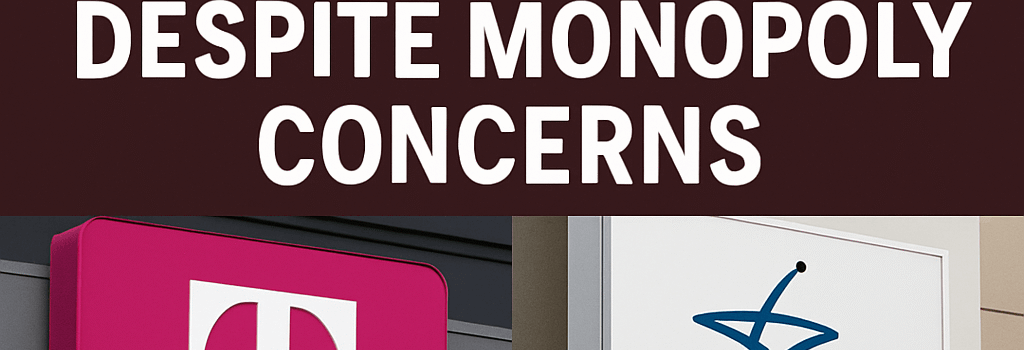DOJ Approves T-Mobile’s US Cellular Deal Despite Monopoly Concerns

By Jon Brodkin • Updated Jul 11, 2025
Grudging Approval with a Warning
The Department of Justice (DOJ) Antitrust Division yesterday issued an unusually candid statement announcing its decision to permit T-Mobile US, Inc. to acquire Sovereign Radiocommunications Company, LLC (US Cellular) wireless assets. Assistant Attorney General Gail Slater, confirmed in March, detailed in a 900-word declaration that the transaction further concentrates spectrum and market power among the “Big 3”—T-Mobile, AT&T, and Verizon—which together control over 80% of licensed mobile wireless spectrum and 90% of mobile subscriptions nationwide.
“This transaction comes near the tail end of a decades-long trend toward consolidation-by-acquisition,” Slater said. “The Big 3 now account for more than 90% of the roughly 335 million mobile subscriptions in the United States.”
Deal Structure and Financials
- T-Mobile will pay $4.4 billion for ~30% of US Cellular’s spectrum licenses (primarily in 600 MHz and 2.5 GHz bands) and its regional wireless operations.
- AT&T and Verizon each agreed to purchase spectrum licenses from US Cellular for ~$1 billion apiece, adding low-band (<600 MHz) holdings that offer superior rural propagation.
- Combined, these transactions transfer ~150 MHz of contiguous mid-band and low-band spectrum into the portfolios of the Big 3, enhancing their 5G capacity and coverage footprints.
Regulatory Context and FCC Coordination
In parallel, T-Mobile agreed to terminate its diversity, equity, and inclusion (DEI) policies at the behest of the Trump administration, a concession that unlocked Federal Communications Commission (FCC) approval for its joint venture to acquire Metronet’s fiber assets. FCC Chairman Brendan Carr has signaled he will greenlight mobile mergers if DEI programs are sunsetted—a policy stance that may influence final FCC conditions on the US Cellular carve-up.
FCC’s Public Interest Standard
Under Section 310(d) of the Communications Act, the FCC must determine whether transactions serve the public interest. Potential remedies include:
- Mandating voluntary wholesale access to MVNOs or smaller operators;
- Requiring phone unlocking within 60 days to facilitate carrier switching;
- Imposing spectrum caps or divestiture of overlapping holdings.
Technical Implications for 5G Networks
By integrating US Cellular’s infrastructure—built largely on 5G New Radio (NR) in 600 MHz and 2.5 GHz bands—T-Mobile plans to:
- Enhance average cell throughput by up to 50% via carrier aggregation of low-band and mid-band spectrum.
- Expand rural coverage using 600 MHz’s superior propagation, filling gaps in areas where sub-6 GHz signals previously underperformed.
- Accelerate deployment of Open RAN architectures to virtualize baseband processing and reduce vendor lock-in.
Spectrum Management and Auction Dynamics
Over the past decade, the FCC has auctioned mid-band holdings in the 3.45 GHz and C-band (3.7–3.98 GHz), incentivizing carriers to outbid challengers. With the Big 3’s bolstered balance sheets, future auctions—such as the upcoming mmWave 26 GHz sale—could see even fewer entrants. Independent operators and rural providers warn that rising bid thresholds and spectrum stockpiling will raise barriers to entry.
Impact on Rural Coverage and Infrastructure
Small carriers, represented by the Rural Wireless Association (RWA), argue that consolidation erodes competitive pressure to invest in sparsely populated regions. They contend:
- Rural consumers face higher prices and slower innovation when large carriers capture all low-band spectrum.
- Local operators, once the only affordable option in many counties, can no longer sustain multi-band network upgrades.
- Public-private partnerships and Rural Digital Opportunity Fund (RDOF) subsidies may not fully offset the reduction in mid-tier competitors.
Regulatory Landscape and Future Implications
Despite DOJ’s decision, the Antitrust Division underscored its willingness to intervene in future deals that threaten competitive entry. Gail Slater’s closing remarks stressed:
“Where future spectrum consolidation transactions threaten the path for a fourth national player to emerge, the Antitrust Division stands ready to investigate and use its enforcement power to protect competition and American consumers.”
Political shifts in Congress and upcoming FCC commissioners could recalibrate merger oversight. Meanwhile, the potential expansion of Dish Network’s fixed wireless access (FWAA) service and DISH’s LTE/5G roaming arrangements with T-Mobile will be scrutinized for their competitive impact.
Expert Perspectives
Harold Feld, Senior VP at Public Knowledge, observed: “The DOJ release reads more like a condemnation than an approval. Regulators need stronger tools to curb spectrum monopolization.”
Daniel Hanley of the Open Markets Institute added: “If Slater feels hamstrung by policy, she has the option to resign in protest. Enforcing antitrust statutes is Congress’s mandate.”
Conclusion
While T-Mobile expects immediate network synergies and enhanced 5G performance for former US Cellular subscribers, regulators and consumer advocates warn that further concentration in spectrum and subscriber share may stifle innovation, dampen price competition, and undermine rural broadband goals. The FCC’s impending public interest review and possible conditions will be decisive in shaping the next decade of U.S. wireless competition.